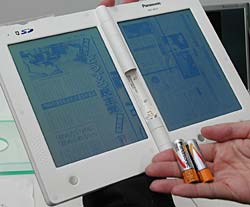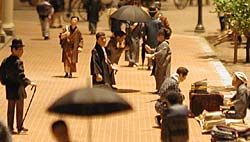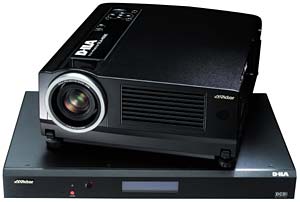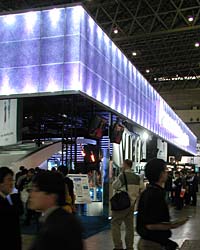Home Entertainment Blog Archive
Brought to you by your friendly, opinionated, Home Entertainment and Technology writer, Stephen DawsonHere I report, discuss, whinge or argue on matters related to high fidelity, home entertainment equipment and the discs and signals that feed them. Since this Blog is hand-coded (I like TextPad), there are no comments facilities. But feel free to email me at scdawson [at] hifi-writer.com. I will try to respond, either personally or by posting here emails I consider of interest. I shall assume that emails sent to me here can be freely posted by me unless you state otherwise.
This archive is for an uncertain period commencing Thursday, 9 October 2003
I've just been skimming the September 2003 issue of Klips, a newsletter published by
Jim Tate Stereo in South Australia. Quite interesting, but I simply must object to one part that jumped off the page. It is part of a guide to listening to equipment with a view to choosing the best piece to buy:
Since the perceived pitch of a note consists of the sum of its fundamental plus its harmonics, a distortion that adds extra harmonics will shift the pitch of that note up slightly. Likewise, a distortion that results in the rolling-off of higher frequencies (thus reducing the amplitude of some harmonics) can lower the perceived pitch.
At the risk of offending, this is entirely wrong. Yes, most
distortion adds
harmonics. Indeed it adds harmonics not only to the fundamental (thus boosting some of the natural harmonics of the instrument so effected), but adds harmonics to the natural harmonics already on the recording. But harmonic distortion does not change the perceived pitch of the sound.
The sound of an instrument is determined by a number of different characteristics: its level, its pitch, its attack and decay and its timbre. For the most part (very deep bass sometimes excluded), the pitch is determined by the fundamental frequency of the sound. Distortion does not alter this. The character of the sound is determined primarily by attack, decay and timbre. Ignore the first two and consider a sustained note. A violin plays a note. A flute plays the same note. The fundamental frequency is the same for both. But the timbre is different, and that is why they sound different. Timbre is the determined by the proportion of harmonic components (and, in some instruments, non-harmonic components) in the note. Harmonic distortion changes the balance of these harmonic components. If harmonic distortion changed the perceived pitch, it would be impossible to play a flute and violin in tune with each other.
(On a more technical level, the ear is constructed somewhat like a Fourier analyser. It breaks down an incoming signal into several distinct frequency bands and processes them separately. That is why when you listen to a complex tone, like that produced by a violin, you can almost perceive the harmonic components on their own. But the fundamental frequency remains at its frequency, perceived by the relevant section of the cochlea and its associated nerve, regardless of the harmonic components accompanying the signal which are perceived in narrower parts of the cochlea and delivered to the brain by parallel nerves.)
Listening to the tune is a very useful technique for evaluating equipment, but for a different reason than that stated here. On low quality equipment, the tune can get lost in the muck. While harmonic distortion is a problem (at significant levels, particularly with odd-order harmonics, it can sound very harsh and make a violin sound less like it ought to thanks to the timbral changes), one of the most important factors distinguishing good from poor gear is spurious noise. This can come from ringing in speaker drivers, or simply lack of control so that they continue to produce sound after they are supposed to have stopped. If you listen not to the main tune in a piece of music, which is normally delivered at a fairly high level, but to one of the sub-themes playing along at the same time, you ought to be able to follow it. Unless, that is, the system is producing muck that obscures it.
 Thursday last week in Tokyo was my last day in Japan. In the morning we went to the Panasonic Centre, which is largely a high tech display of Panasonic products, technologies and visions for the future. A fair bit of interesting stuff there, including Panasonic's transparent panel speakers. Still trying to determine precisely how they work (apparently it's something to do with a driver in close proximity, but not actually touching, the panel). Anything but high fidelity sound (very coloured, crunchy upper midrange) but obviously a useful device in many circumstances.
Thursday last week in Tokyo was my last day in Japan. In the morning we went to the Panasonic Centre, which is largely a high tech display of Panasonic products, technologies and visions for the future. A fair bit of interesting stuff there, including Panasonic's transparent panel speakers. Still trying to determine precisely how they work (apparently it's something to do with a driver in close proximity, but not actually touching, the panel). Anything but high fidelity sound (very coloured, crunchy upper midrange) but obviously a useful device in many circumstances.
The most interesting device was the Panasonic E Book (model BKE-AW-N7). Concept is simple, a light weight, low powered pair of LCD panels that fold like a book. Stick in a Secure Digital card with electronic books in it and you can read them on the screen. Nothing too revolutionary there. But this thing runs on two AA batteries for a claimed three to six months. How does it manage that? The trick is that the LCD screen draws no power during static display, only when the page is updated. The photo (which I took) shows the display in operation with the batteries removed. Clever huh?
Far from perfect: monochrome only, no backlight and the contrast was quite low. Still, another couple of years of development and this could be a real killer technology. The screen's resolution also seemed to be very high. Current price: 37,900 yen, or around $AUS500.
 That afternoon we went through the Edo-Tokyo museum which had a bunch of fascinating displays showing the four hundred year history of the city. Lots of artifacts, a slightly cut down version of a famous wooden bridge, and some incredibly detailed street models (see photo). The people are only around a centimetre tall. No home entertainment technology there worth mentioning, though.
That afternoon we went through the Edo-Tokyo museum which had a bunch of fascinating displays showing the four hundred year history of the city. Lots of artifacts, a slightly cut down version of a famous wooden bridge, and some incredibly detailed street models (see photo). The people are only around a centimetre tall. No home entertainment technology there worth mentioning, though.
Interesting plaque describing the 1930s: 'It was during such a period that the "Manchurian Incident" occurred in September 1931, followed by the founding of Manchukuo in the northeastern part of China. These events not only affected Japan's relations with China, but also disturbed the international order and Japan's position in the international community. With the Marco Polo Bridge Incident in the suburbs of Beijing in July 1937, Japan plunged into all-out war with China ... [Some discussion of war time conditions] ... Then, in December 1941, the Pacific War began."
Interesting take on these things. Particularly how they just kind of happened. Clearly there is not much of a 'black arm-band' view of history at this museum at least.
A web page for a major Australian electronics retailer says that the Fujitsu 106cm plasma display, P42VHA20 has the following features:
- High Definition 42-inch (16:9)
- 852 x 480 pixel panel
 Okay, okay. My favourite product of the show isn't available just yet. It is a new projector -- the DLA-HD2K -- from JVC using its in-house developed
D-ILA projection panel (this is a form of Liquid Crystal on Silicon -- LCOS -- which means it is reflective rather than transmissive. That in turn means very thin pixel boundaries, for virtually no
screen door effect).
Okay, okay. My favourite product of the show isn't available just yet. It is a new projector -- the DLA-HD2K -- from JVC using its in-house developed
D-ILA projection panel (this is a form of Liquid Crystal on Silicon -- LCOS -- which means it is reflective rather than transmissive. That in turn means very thin pixel boundaries, for virtually no
screen door effect).
What sets this projector apart is that it is true high definition: a full 1,920 pixels horizontally by 1,080 vertically, in 16:9 widescreen format. All those pixels are stuffed onto a D-ILA panel measuring 0.8 inches (20.32mm), or not much larger than the Mustang DMDs which offer 1,280 by 720 pixels. The projector uses three of these, one for each colour, whereas most DLP projectors make do with one panel and a colour wheel. JVC had four D-ILA panels on display, up to a 1.7 inch model that offers 3,840 by 2,048 pixels!
But back to this new HD projector. JVC has worked with Faroudja to develop suitable scaling technology. The projector has actually been designed as a two-box unit. The projector itself has a single input (plus a few control sockets) consisting of a DVI socket. All the normal inputs are on a separate slim box of electronics, which also contains the Faroundja DCDi scaling circuits. Fortunately, this also has a DVI input for support for forthcoming DVD players and digital TV receivers.
So how well did it work? JVC had a theatrette in the centre of its display stand and a high definition digital tape with a couple of movie trailers. Unfortunately I couldn't sit as close to the screen as I wanted to, but it was still a big picture from my vantage. On this source the picture was absolutely impeccable on the issues I was looking for.
 What I was looking for was resolution-related issues. There was no visible screen door effect at all. None. Not a skerrick. One of the least satisfactory aspects of all digital projectors is the sometime squiggles as a tiny detail or a boundary between projected objects is difficult for the electronics to allocate to particular pixels, resulting in an unsteadiness and slight flicker as these details wobble between pixels, producing a squiggly effect. There was absolutely none of this.
What I was looking for was resolution-related issues. There was no visible screen door effect at all. None. Not a skerrick. One of the least satisfactory aspects of all digital projectors is the sometime squiggles as a tiny detail or a boundary between projected objects is difficult for the electronics to allocate to particular pixels, resulting in an unsteadiness and slight flicker as these details wobble between pixels, producing a squiggly effect. There was absolutely none of this.
One thing I forgot to pay attention to until it was too late was black levels, but my impression was that they were very deep and dark indeed. Indeed, colour performance was both rich and natural, particularly on greenery.
In short, this projector, with its high definition source, produced a far better result than I have ever seen in a real cinema, let alone a home theatre setup. Focus incredibly sharp, yet the overall picture amazingly smooth.
How well it works with standard definition material remains to be seen. But, wow, I'm looking forward to this one!
BTW, price has not been determined as yet. But I would expect it to start at something like $US20,000.
UPDATE (Thursday, 16 October 2003, 9:19 am): I emailed some questions on this projector to Mr Akira (Alex) Kobayashi at JVC in Japan. Mr Kobayashi tells me that the model number for this projector is not finally settled, nor are all the specifications. However the unit at the show was delivering around 600 ANSI lumens (just about the right level for most home cinema applications). More importantly, it delivered a contrast ratio of 2,200:1. This is a vast improvement over the DLA-SX21 and puts it right up there in DLP territory. No wonder I didn't think to look at the black levels. You don't think of these things unless something triggers your attention, like poor performance. But in this case the performance was great.
 Gee I love overnight flights, followed by a local flight that finally gets me home just a bit before lunch. Plane out of Tokyo was chockablock, so not much room for stretching there.
Gee I love overnight flights, followed by a local flight that finally gets me home just a bit before lunch. Plane out of Tokyo was chockablock, so not much room for stretching there.
Our first day in Tokyo was largely spent at CEATEC (Combined Exhibition of Advanced Technologies). A massive display it was, but perhaps only a quarter of it was devoted to home entertainment technology. The rest: communications and components.
There were big stands by Panasonic, Sony, Sharp, Sanyo, Hitachi, JVC and Pioneer. The only non-Japanese home entertainment company stand was a smallish one for Bose. There were also three stands devoted to DVD recording technology: one for DVD-RAM, one for DVD+RW/R and one for DVD-RW/R. There were also stands for SD (Secure Digital flash memory cards) and Japan's numerous high definition broadcasters. Noticably absent were other strong Japanese brands like Yamaha, Marantz, Denon and Onkyo. NEC was there, but more in an info-tech than home entertainment capacity.
Most of the major brands were focusing on panel displays: plasma and LCD. Most had a Blu-ray player with high definition stuff playing. Most had a 3-D display of some kind. Panasonic's version used a fairly large screen, rear projection, right-angled polarisation of the light from the two projectors showing the slightly different angles, and polarised eyewear for viewing. It actually looked very good. Rather than really flashy stuff, Panasonic used a recent baseball game for the demonstration. The others used small LCD panels that required no eyewear to work. These appeared to work by using an overlay that allowed only the appropriate portion of the image to seen by each eye. These tended to produce a rippling effect if you moved sideways while watching, which was absent in Panasonic's effort. Both, though, had a reasonably restricted viewing angle.
My product pick of the show? Read the entry above.